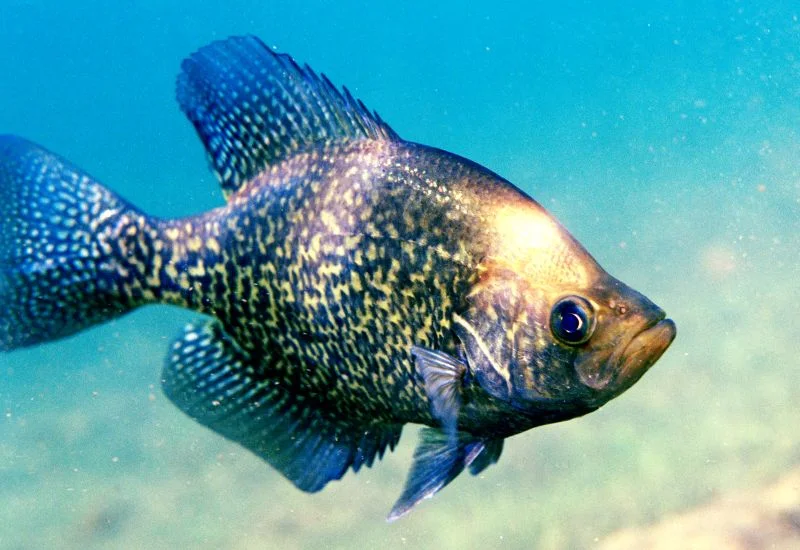If you are in search of a delicious fish, Crappie will be an excellent choice for you. Crappie, which is much like a bass and bluegill, comes into the category of game fish. Fishing this game fish is fun for people of all ages and skill levels.
Moreover, fishing this species is very easy. As they mostly hang out in shallower water, you can trap them easily. Additionally, you can use several types of lures and baits for this species. They bite these baits immediately, and their sensitive mouths are trapped easily.
As Crappies are abundant, delicious, and attractive, most fishing schools start their fishing classes with Crappies.
An Overview of Crappie Fish
| COMMON NAME | Papermouths, Strawberry bass, Speckled bass, Specks, Speckled perch, Calico bass, Oswego bass |
| SCIENTIFIC NAME | Pomoxis nigromaculatus (Black), Pomoxis annularis (White) |
| TYPE | Ray-finned fish |
| DIET | Omnivores |
| GROUP NAME | Sunfish family member |
| SIZE | 4-8 inches / 10-20 cm |
| Weight | 3-4 lbs |
| Color | Black, White, Green, Silver |
| Skin type | Scales on the skin |
Reason Of Name
As crappies have sharp gills cover, these are named Pomoxis, which means sharp cover. This is a Greek word given to all the fish having such sharp mouths. However, due to their relation with the sunfish family, these are named crappies. This word comes from the Canadian French carpet.
In Southern Louisiana, people call it sac-a-lait, which means “milk bag.”
Anatomy And Appearance
Crappie fish have a large body with a large mouth but a small head. Their mouth is like a transparent paper. The body has a plate-like shape. It has big jaws that even cover the eyes. These fish come in several shades of color. The sides are dark green. The down part is black. However, the stomach gives a silvery yellow shade.
There are two types of fins: hard and soft fins. Crappie fish have 17-19 anal soft fins and 15-16 dorsal soft fins. Both fins increase in size from the front to the rear. You will observe up to eight dorsal and anal fins. Crappie fish have dark spots or bands on the tails and fins. But these blotches can fade depending upon the time of the year.
Crappie fish can grow a maximum of five pounds seven ounces. However, when the eggs hatch, the larvae are only 0.1 inches or 0.09 inches in length. After developing scales, the size of Crappie reaches 1.2 inches or 1.1 inches. The size of a 4 to 5-year-old Crappie is about 10 inches.
Fish Species
Crappie is a popular predatory fish. It is a medium-sized fish in the freshwater ecosystem. Many other larger fish such as Catfish, Walleye, Sander vitreus, Northern Pike, Esox Lucius, and Bass prey on this fish. So it plays an important role in the food chain.
There are only two further species of crappies, the Black and White crappies. However, artificial culturing has developed Hybrid Crappie. They have more similarities with the Black Crappie than with the White Crappie.
BLACK CRAPPIE VS. WHITE CRAPPIE
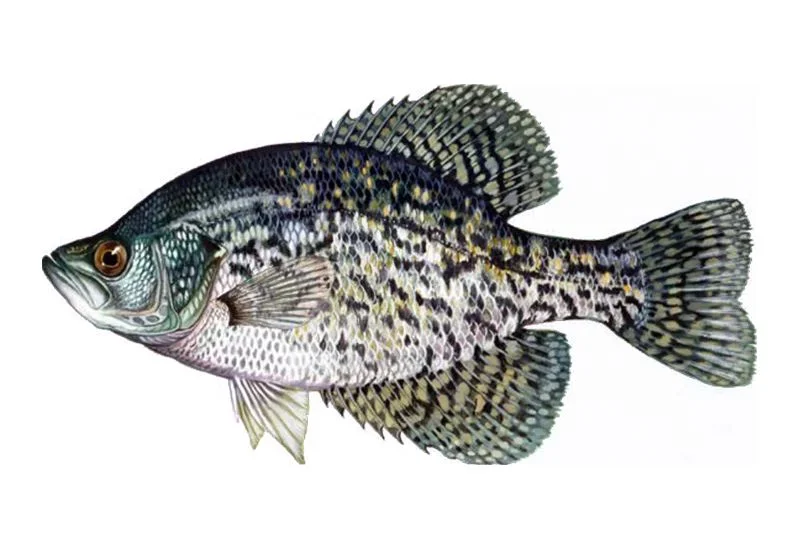
Crappie fish have two types. One is the Black Crappie and the other is the White Crappie. The very first difference comes in their appearance. These fish are not distinguished by colors but through the patterns of the color. There are dark spots on the body of the White Crappie while dark bands on the body of the Black Crappie.
| Features | Black Crappie | White Crappie |
|---|---|---|
| Colors | Light color | Dark color |
| Spines | 13 to 16 | 10 to 13 |
| Body shape | Compressed and deeper | Flattened and longer |
| Fins | 7 to 8 dorsal rays7 to 8 anal rays | 6 dorsal rays 6 anal rays |
| Blotches | Irregular dark blotches | Regular dark bars |
| Weight | Heavier | Lighter |
| Size | Shorter but rounded | Bigger and londer |
| Habitat | Clear water | Both clear and muddy areas |
| Spawning temperature | 60 to 64 °F / 15 to 17 °C | 65 to 70 °F / 18 to 21 °C |
| Number of eggs | 20,000 to 140,000 eggs | 1000 to 200,000 eggs |
Behavior and Reproduction
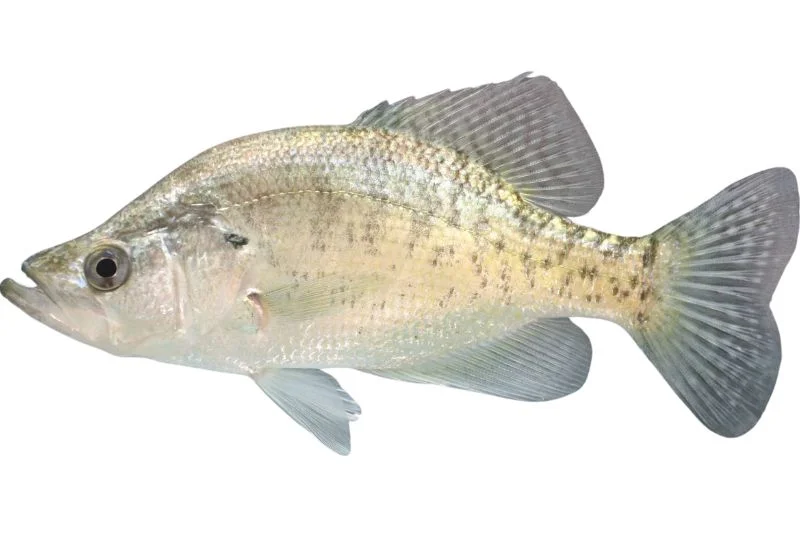
Crappie fish have an estimated age of 15 years but in optimum conditions. However, after two years, they are mature enough to lay eggs. The mating season actually occurs from spring to summer and starts from the month of March to July.
Reproduction is the same in both the White and Black species of Crappie fish. It starts with the male fish when they start building nests in shallow areas such as brush piles, timber, or rocks. They build their nests of about 60 cm on sand, gravel, and hard substrates such as rock or wood.
When the temperature reaches to 14 degrees Celsius, both the male and female approach their nests. The female will start laying eggs. In the whole season, they will lay eggs up to 50 times in their nests. The eggs will stick to the nests due to their adhesive property. However, male crappies are there to protect the eggs the whole time.
Fry will remain in the nest for two to six days and males will still protect them. After this process, the male and female will remain away from each other until the next spawning season.
Interaction With Humans
Pomoxis annularis doesn’t affect human life. Sometimes, their population can increase due to the absence of predators. However, humans are disturbing their population due to overfishing. There are no strict conservation policies for Crappie fish.
Feeding
Crappies mostly feed in the morning and evening times. Some people consider them nocturnal, although some Black crappies hang out in the daytime for food. The young ones start feeding with the small items, but after one or two years, they move towards the larger crustaceans, insects, etc.
The main food of these fish includes the smaller fish such as bluegill, minnows, northern pike, muskellunge, walleye, and silversides. The other food includes microscopic crustaceans such as zooplankton, small threadfin, gizzard shad, insect larvae, mayflies, etc.
As Crappie fish are found in various areas of America and Canada, their food will also vary depending on the location, temperature, water conditions, forage base, etc.
Tips For Fishing
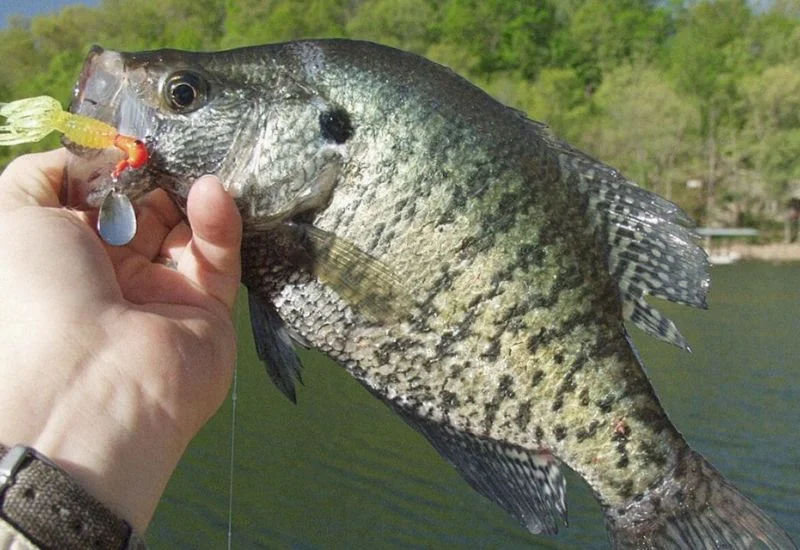
Crappie fish live in a wide variety of waters. You can spot these fish in lakes, ponds, backwaters pools, slow rivers, streams, large reservoirs, etc.
You can fish crappies all around the year from the banks of freshwater bodies. As these fish increase in number in spring and fall, most fishermen prefer this time to fish them. The fishermen spot the shallow areas near tree limbs and brush piles for trapping Crappie fish.
Fishing Gear
The gear for fishing includes a limber rod, a reel, a light line, and bait. As it is a soft-mouthed fish, the rod should be sensitive and lightweight. A six to seven feet long rod is considered suitable for these specks. You will need a 1000 to 2000-sized spinning reel to catch easily. However, you can cast with a 500-size reel.
Lures
This Speckled Bass bites the baits and lures immediately. Its baits include the following.
- Live minnows
- Crankbaits
- Plastic jigs
- Brands
- Fishing baits
- Bobby Garland Baby Shad
- Marabou Jigs
- Spinner
- Rapala
- Jigging spoons
Fishing Techniques
People use several techniques to fish this species. Some of the most common techniques are as follows.
- Vertical jiggling
- Trolling
- Casting
- Spider rigging
- Shooting docks
- Pushing jigs
However, spider rigging and long-line trolling proved most fruitful during fishing. In this trolling, they troll eight poles from the front and the back of the boat with different lures at different speeds.
Conservation
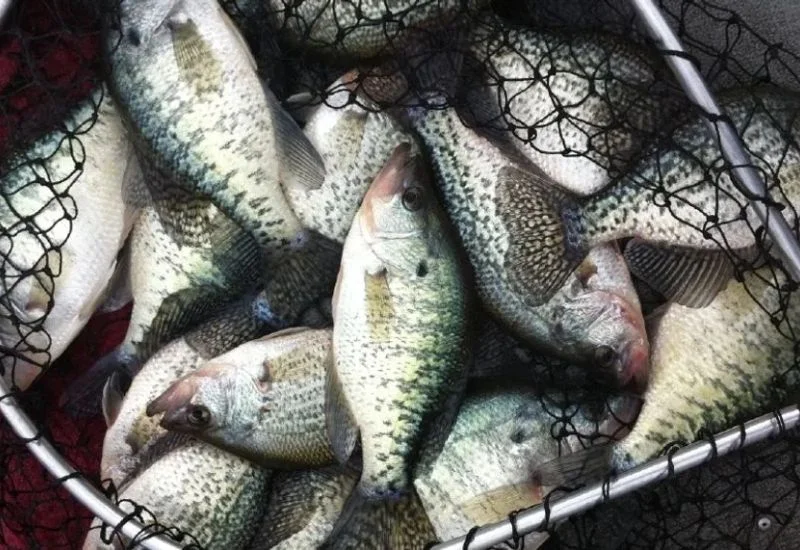
Crappie is found in America and Canada. Moreover, their native area is North America. If we go more specifically, they are found in the Mississippi River. During dawn and dusk, you can spot them on the river shores.
However, due to the high demand for Crappie fish, it is introduced in all 48 states of America and different parts of Canada.
Crappie fish are endangered for several reasons, such as their slow population growth rates, high harvesting, and too much fishing.
Crappie Fish Recipe
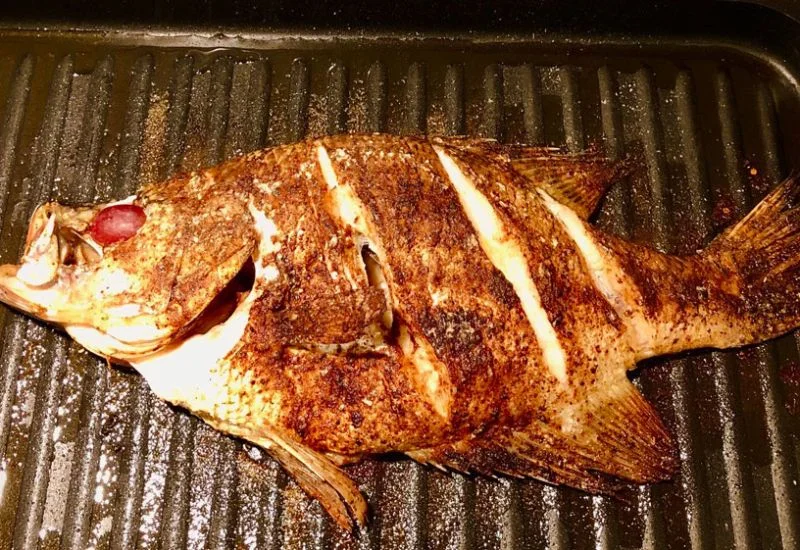
The sweet, mild, and white meat of Crappie has a number of dishes. You can fry, steam, or grill this fish and eat it along with vegetables.
Its meat is full of the nutrients mentioned below.
- Saturated fat
- Monounsaturated fat
- Polyunsaturated fat
- Protein
- Cholesterol
- Sodium
- Potassium
Frying
The easiest way to enjoy this delicious fish is to fry it. You can prepare this dish by yourself in less than an hour. Just have the following items with you.
- Plastic wrap
- Crappie filets
- Flour
- Eggs
- Paprika
- Garlic powder
- Black pepper
- Breadcrumbs
- Vegetable oil
First of all, put the fish filets in the center of the plastic wrap. Then make the mixture of the paprika, garlic powder, black pepper, and breadcrumbs in a bowl. Now pour the mixture in the form of a layer over the filets layer. Wrap the plastic tightly.
It’s time to make another mixture of flour and eggs and make a thick paste. Coat the filets wrapped with plastic with this paste.
Now, heat the vegetable oil in the frying pan. When it starts frying, put the filets in it and let them fry for 20 minutes. Wait for the filet to become crisp and brown.
When the filets appear golden brown, you can remove them from the pan.
Baking
It’s another easy way to eat this white flesh fish. To bake this fish, you will need the following ingredients:
- Six fish that are scaled, gutted, headless
- Butter
- Lemon
- Chopped fresh parsley
- Cajun spice
- Pepper salt
- Fresh rosemary
Grilling
Grilling takes the least time to cook the Crappie fish. Its recipe includes the following.
- Fish filets
- Paprika
- White pepper
- Garlic powder
- Olive oil
First of all coat the filets with olive oil. Make the mixture of the spices and sprinkle this mixture on the fish. Now place these pieces of fish on the grilling tray or grill with sticks. Let it grill for three to five minutes and then flip it. In this way, you will cook both sides of the fish.
Keeping Crappie In An Aquarium
Crappie thrives mostly in freshwater bodies and slow-moving water with no currents. These fish, like rock piles, artificial reefs, brush piles, and such surfaces to make their habitats.
However, some species of this fish can adapt to turbid waters. The optimum pH for Crappie fish is 6.5 to 8.5. Moreover, the oxygen levels must be as low as three ppm in water. These fish prefer saline waters.
These are fish species that are kept in outside ponds. However, you can keep them in your aquariums by setting it in the following manner.
- Take a tank of a minimum of 80 gallons or 300 liters. Spread dark-colored gravel or sand and make a thin layer on the base. Add driftwood pieces, artificial plants, and rooks in the aquarium.
- Now fill it with the water. Install a de-chlorinator and a heater. Crappie fish thrives well at 55 to 86 °F/ 13–30 °C. To keep the tank clean, add an external canister filter. You have to clean the tank completely after every two weeks.
- Now, the tank is ready to use. You can introduce the fish in this aquarium now. However, float the plastic bag in the aquarium for 20 minutes.
- This fish requires food after every 12 hours. You can feed it with a one-inch small fish or an insect larva twice a day. However, you can use fish pellets as their food.
Tank Partners
Crappie is a freshwater fish, and only other freshwater species can survive with it. But make sure the tank is larger than 300 liters. Bluegill and Pumpkinseed are mostly kept in its tank.
Conclusion
If you want to arrange a trip for fishing, crappies should be your top priority. However, you should research first the fish, the best places to find them, the best lures for them, best techniques for fishing them.
This fish includes the most sensitive fish as they can see in low light and detect even the smallest vibrations. So it can be a challenge for you to fish if your fishing rod is sturdy.
I hope this comprehensive and in-depth guide proves beneficial to you.
